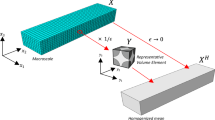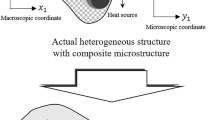Abstract
Asymptotic homogenization (AH) is a general method for predicting the effective coefficient of thermal expansion (CTE) of periodic composites. It has a rigorous mathematical foundation and can give an accurate solution if the macrostructure is large enough to comprise an infinite number of unit cells. In this paper, a novel implementation algorithm of asymptotic homogenization (NIAH) is developed to calculate the effective CTE of periodic composite materials. Compared with the previous implementation of AH, there are two obvious advantages. One is its implementation as simple as representative volume element (RVE). The new algorithm can be executed easily using commercial finite element analysis (FEA) software as a black box. The detailed process of the new implementation of AH has been provided. The other is that NIAH can simultaneously use more than one element type to discretize a unit cell, which can save much computational cost in predicting the CTE of a complex structure. Several examples are carried out to demonstrate the effectiveness of the new implementation. This work is expected to greatly promote the widespread use of AH in predicting the CTE of periodic composite materials.







Similar content being viewed by others
References
Sigmund, O., Torquato, S.: Design of materials with extreme thermal expansion using a three-phase topology optimization method. J. Mech. Phys. Solids. 45, 1037–1067 (1997)
Steeves, C.A., Evans, A.G.: Optimization of thermal protection systems utilizing sandwich structures with low coefficient of thermal expansion lattice hot faces. J. Am. Ceram. Soc. 94, S55–S61 (2011)
Zhang, X.X., Xiao, B.L., Andra, H., et al.: Multi-scale modeling of the macroscopic, elastic mismatch and thermal misfit stresses in metal matrix composites. Compos. Struct. 125, 176–187 (2015)
Palumbo, N.M.A., Smith, C.W., Miller, W., et al.: Near-zero thermal expansivity 2-D lattice structures: performance in terms of mass and mechanical properties. Acta Mater. 59, 2392–2403 (2011)
Ozaki, T., Naito, K., Mikami, I., et al.: High precision composite pipes for SOLAR-B optical structures. Acta Astronaut. 48, 321–329 (2001)
Schapery, R.A.: Thermal expansion coefficients of composite materials based on energy principles. J. Compos. Mater. 2, 380–404 (1968)
Chamis, C.C., Sendeckyj, G.P.: Critique on theories predicting thermoelastic properties of fibrous composites. J. Compos. Mater. 2, 332–358 (1968)
Walter, B., Rosen, Z.H.: Effective thermal expansion coefficients and specific heats of composite materials. Int. J. Eng. Sci. 8, 157–173 (1970)
Hashin, Z.: Analysis of composite materials, a survey. J. Appl. Mech. 50, 481–505 (1983)
Bowles, D.E., Tompkins, S.S.: Prediction of coefficients of thermal expansion for unidirectional composites. J. Compos. Mater. 23, 370–388 (1989)
Shen, Y.L.: Thermal expansion of metal-ceramic composites: a three-dimensional analysis. Mater. Sci. Eng. A 252, 269–275 (1998)
Islam, M.D.R., Sjolind, S.G., Pramila, A.: Finite element analysis of linear thermal expansion coefficients of unidirectional cracked composites. J. Compos. Mater. 35, 1762–1776 (2001)
Karadeniz, Z.H., Kumlutas, D.: A numerical study on the coefficients of thermal expansion of fiber reinforced composite materials. Compos. Struct. 78, 1–10 (2007)
Hu, C.X., Zhang, S.Y., Song, Y.S.: Numerical simulation on thermal expansion coefficient of 3D braided C/C composites. Rare Met. 33, 99–106 (2004)
Ai, S.G., Fu, H.L., He, R.J., et al.: Multi-scale modeling of thermal expansion coefficients of C/C composites at high temperature. Mater. Design 82, 181–188 (2015)
Abueidda, D.W., Dalaqa, A.S., Al-Ru, R.K.A., et al.: Micromechanical finite element predictions of a reduced coefficient of thermal expansion for 3D periodic architectured interpenetrating phase composites. Compos. Struct. 133, 85–97 (2015)
Mei, C.C., Vernescu, B.: Homogenization methods for multiscale mechanics. World Scientific, New York (2010)
Kalamkarov, A.L., Hassan, E.M., Georgiades, A.V., et al.: Asymptotic homogenization model for 3D grid-reinforced composite structures with generally orthotropic reinforcements. Compos. Struct. 89, 186–196 (2009)
Lapeyronnie, P., Grognec, P.L., Binétruy, C., et al.: Homogenization of the elastic behavior of a layer-to-layer angle-interlock composite. Compos. Struct. 93, 2795–2807 (2011)
Hollister, S.J., Kikuchi, N.: A comparison of homogenization and standard mechanics analyses for periodic porous composites. Comput. Mech. 10, 73–75 (1992)
Lefik, N., Schrefler, B.A.: 3D finite element analysis of composite beams with parallel fibres, based on homogenization theory. Comput. Mech 14, 2–15 (1994)
Liu, S.T., Cheng, G.D.: Study of predicting thermal conductivity of spherical porous material. J. Dalian. Univ. Technol. 34, 137–144 (1994) (in Chinese)
Liu, S.T., Cheng, G.D.: Study of the thermal conductivity of porous material. Comput. Struct. Mech. Appl. 11, 147–153 (1994) (in Chinese)
Liu, S.T., Zhang, Y.C.: Multi-Scale analysis method for thermal conductivity of porous material with radiation. MMMS 2, 327–344 (2006)
Berger, H., Gabbert, U., Koppe, H., et al.: Finite element and asymptotic homogenization methods applied to smart composite materials. Comput. Mech. 33, 61–67 (2003)
Liu, S.T., Cheng, G.D.: Homogenization-based method for predicting thermal expansion coefficients of composite materials. J. Dalian. Univ. Technol. 35, 451–457(1995) (in Chinese)
Terada, K., Kurumatani, M., Ushida, T., et al.: A method of two-scale thermo-mechanical analysis for porous solids with micro-scale heat transfer. Comput. Mech. 46, 269–285 (2010)
Cheng, G.D., Cai, Y.W., Xu, L.: Novel implementation of homogenization method to predict effective properties of periodic materials. Acta. Mech. Sin. 29, 550–556 (2013)
Cai, Y.W., Xu, L., Cheng, G.D.: Novel numerical implementation of asymptotic homogenization method for periodic plate structures. Int. J. Solids. Struct. 51, 284–292 (2014)
Wang, B., Tian, K., Hao, P., et al.: Hybrid analysis and optimization of hierarchical stiffened plates based on asymptotic homogenization method. Compos. Struct. 132, 136–147 (2015)
Xu, L., Cheng, G.D., Yi, S.N.: A new method of shear stiffness prediction of periodic Timoshenko beams. Mech. Adv. Mater. Struct. 23, 670–680 (2016)
Yi, S.N., Xu, L., Cheng, G.D., et al.: FEM formulation of homogenization method for effective properties of periodic heterogeneous beam and size effect of basic cell in thickness direction. Comput. Struct. 156, 1–11 (2015)
Yu, W.B., Tang, T.: A variational asymptotic micromechanics model for predicting thermoelastic properties of heterogeneous materials. Int. J. Solids. Struct. 44, 7510–7525 (2007)
Steeves, C.A., e Lucato, S.L.S., He, M.: Concepts for structurally robust materials that combine low thermal expansion with high stiffness. J. Mech. Phys. Solids. 55, 1803–1822 (2007)
Steeves, C.A., Mercer, C., Antinucci, E., et al.: Experimental investigation of the thermal properties of tailored expansion lattices. Int. J. Mech. Mater. Des. 5, 195–202 (2009)
Acknowledgements
The project was supported by the National Natural Science Foundation of China (Grants 11332004, 11572071), the Program for Changjiang Scholars and Innovative Research Team in Dalian University of Technology (PCSIRT), 111 Project (Grant B14013), and the CATIC Industrial Production Projects (Grant CXY2013DLLG32). We would also like to thank the Fundamental Research Funds for the Central Universities (Grant DUT15ZD101).
Author information
Authors and Affiliations
Corresponding author
Appendix
Appendix
This APDL command was used to compute the CTE of fiber reinforced composites.
FINISH
/CLEAR
/PREP7
/NERR,0
!! Geometric parameters
L=1
H=L
Y=L*L*H ! Volume of the unit cell
R= L/5 ! Radius of fiber
!! Material properties of fiber
EL1=23.1E9
ET1=233.1E9
GLT1=8.97E9
GTT1=8.28E9
VLT1=0.20
VTT1=0.40
AL1=-0.3E-6
AT1=5.6E-6
!! Material properties of matrix
E2=4.34E9
G2=1.59E9
V2=0.37
A2=24.4E-6
PI=3.1415926
!! Set element and material model
ET,1,SOLID185
MP,EX,1,EL1
MP,EY,1,EL1
MP,EZ,1,ET1
MP,NUXY,1,VTT1
MP,NUYZ,1,VLT1
MP,NUXZ,1,VLT1
MP,ALPX,1,AT1
MP,ALPY,1,AT1
MP,ALPZ,1,AL1
MP,GXY,1,GTT1
MP,GYZ,1,GLT1
MP,GXZ,1,GLT1
MP,EX,2,E2
MP,PRXY,2,V2
MP,ALPX,2,A2
!! Geometric model
WPOFF,,,-H/2
BLC5,,,L,L,H
CYL4,,,R,,,,H
VSBV,1,2
CYL4,,,R,,,,H
VGLUE,ALL
WPROTA,,-90
VSBW,ALL
WPROTA,,,90
VSBW,ALL
NUMCMP,ALL
WPROTA,,,45
VSEL,S,VOLU,,5,8,1
VSBW,ALL
ALLSEL,ALL
NUMCMP,ALL
WPROTA,,,90
VSEL,S,VOLU,,5,10,1
VSBW,ALL
NUMCMP,ALL
ALLSEL,ALL
!! Mesh generation
VSEL,S,VOLU,,1,4,1
VATT,1,,1
VSEL,S,VOLU,,5,12,1
VATT,2,,1
ALLSEL,ALL
CSYS,1
LSEL,S,LOC,Z,-L/2
LSEL,A,LOC,Z,L/2
LSEL,R,LOC,X,0,R/2+0.01
CM,L_1,LINE
LSEL,S,LOC,Z,-L/2
LSEL,A,LOC,Z,L/2
LSEL,R,LOC,X,R-0.01,R+0.01
CM,L_2,LINE
CSYS,0
LSEL,S,LOC,Z,0
CM,L_3,LINE
LSEL,ALL
CMSEL,U,L_1,LINE
CMSEL,U,L_2,LINE
CMSEL,U,L_3,LINE
LSEL,R,LOC,X,-L/2+0.01,L/2-0.01
LSEL,R,LOC,Y,-L/2+0.01,L/2-0.01
CM,L_4,LINE
CSYS,1
LSEL,S,LOC,X,(L/4+R/2)-0.01,(L/4+R/2)+0.01
CM,L_6,LINE
CSYS,0
CMSEL,S,L_4
CMSEL,U,L_6
CM,L_7,LINE
LSEL,ALL
CMSEL,U,L_1,LINE
CMSEL,U,L_2,LINE
CMSEL,U,L_3,LINE
CMSEL,U,L_4,LINE
CM,L_5,LINE
ALLSEL,ALL
LESIZE,L_3,,,4
LESIZE,L_1,,,6
LESIZE,L_2,,,6
LESIZE,L_5,,,6
LESIZE,L_6,,,5
LESIZE,L_7,,,5
ALLSEL, ALL
MSHAPE,0,3D
MSHKEY,1
VMESH,ALL
NUMMRG,ALL
NUMCMP,ALL
VGEN, ,ALL, , ,L/2,L/2,H/2, , ,1
!! Parameter definition
*GET,NNODE,NODE,0,COUNT
*DIM,X1,ARRAY,6,NNODE*3
*DIM,FX1,ARRAY,6,NNODE*3
*DIM,X2,ARRAY,6,NNODE*3
*DIM,XB2,ARRAY,1,NNODE*3
*DIM,FX2,ARRAY,6,NNODE*3
*DIM,FB1,ARRAY,1,NNODE*3
*DIM,FB2,ARRAY,1,NNODE*3
*DIM,EH,ARRAY,6,6
*DIM,EH0,ARRAY,6,6
*DIM,BETA,ARRAY,6,1
*DIM,ALPHA,ARRAY,6,1
!! Construct six (3d) nodal displacement fields
*DO,I,1,NNODE
X1(1,3*(I-1)+1)=NX(I)
X1(1,3*(I-1)+2)=0
X1(1,3*(I-1)+3)=0
*ENDDO
*DO,I,1,NNODE
X1(2,3*(I-1)+1)=0
X1(2,3*(I-1)+2)=NY(I)
X1(2,3*(I-1)+3)=0
*ENDDO
*DO,I,1,NNODE
X1(3,3*(I-1)+1)=0
X1(3,3*(I-1)+2)=0
X1(3,3*(I-1)+3)=NZ(I)
*ENDDO
*DO,I,1,NNODE
X1(4,3*(I-1)+1)=0
X1(4,3*(I-1)+2)=NZ(I)/2
X1(4,3*(I-1)+3)=NY(I)/2
*ENDDO
*DO,I,1,NNODE
X1(5,3*(I-1)+1)=NZ(I)/2
X1(5,3*(I-1)+2)=0
X1(5,3*(I-1)+3)=NX(I)/2
*ENDDO
*DO,I,1,NNODE
X1(6,3*(I-1)+1)=NY(I)/2
X1(6,3*(I-1)+2)=NX(I)/2
X1(6,3*(I-1)+3)=0
*ENDDO
*DO,II,1,2
*IF,II,EQ,1,THEN
! ! Solving the Eq. (17) and get the corresponding nodal reaction force
*DO,III,1,6
*DO,I,1,NNODE
D,I,UX,X1(III,3*(I-1)+1)
D,I,UY,X1(III,3*(I-1)+2)
D,I,UZ,X1(III,3*(I-1)+3)
*ENDDO
/SOLU
SOLVE
/POST1
*DO,I,1,NNODE
*GET,FX1(III,3*(I-1)+1),NODE,I,RF,FX
*GET,FX1(III,3*(I-1)+2),NODE,I,RF,FY
*GET,FX1(III,3*(I-1)+3),NODE,I,RF,FZ
*ENDDO
LSCLEAR,ALL
/PREP7
*ENDDO
*ELSEIF,II,EQ,2,THEN
! All the nodal degrees of freedom are fixed
ALLSEL,ALL
NSEL,ALL
D,ALL,UX,0
D,ALL,UY,0
D,ALL,UZ,0
! !Apply thermal loads (-1K) on each node
TREF,0
BFUNIF,TEMP,1
ALLSEL,ALL
! !Get the corresponding nodal reaction force
/SOLU
SOLVE
*DO,I,1,NNODE
*GET,FB1(1,3*(I-1)+1),NODE,I,RF,FX
*GET,FB1(1,3*(I-1)+2),NODE,I,RF,FY
*GET,FB1(1,3*(I-1)+3),NODE,I,RF,FZ
*ENDDO
*ENDIF
*ENDDO
LSCLEAR,ALL
/PREP7
*SET,LX,L
*SET,LY,L
*SET,LZ,H
! Set the periodic boundary conditions
NSEL,S,LOC,X,0
NSEL,R,LOC,Y,0
CM,LINE_Z1,NODE
NSEL,S,LOC,X,LX
NSEL,R,LOC,Y,0
CM,LINE_Z2,NODE
NSEL,S,LOC,X,0
NSEL,R,LOC,Y,LY
CM,LINE_Z3,NODE
NSEL,S,LOC,X,LX
NSEL,R,LOC,Y,LY
CM,LINE_Z4,NODE
CMSEL,S,LINE_Z1
CMSEL,A,LINE_Z2
CMSEL,A,LINE_Z3
CMSEL,A,LINE_Z4
CM,LINE_Z,NODE
NSEL,S,LOC,X,0
NSEL,R,LOC,Z,0
CM,LINE_Y1,NODE
NSEL,S,LOC,X,0
NSEL,R,LOC,Z,LZ
CM,LINE_Y2,NODE
NSEL,S,LOC,X,LX
NSEL,R,LOC,Z,0
CM,LINE_Y3,NODE
NSEL,S,LOC,X,LX
NSEL,R,LOC,Z,LZ
CM,LINE_Y4,NODE
CMSEL,S,LINE_Y1
CMSEL,A,LINE_Y2
CMSEL,A,LINE_Y3
CMSEL,A,LINE_Y4
CM,LINE_Y,NODE
NSEL,S,LOC,Y,0
NSEL,R,LOC,Z,0
CM,LINE_X1,NODE
NSEL,S,LOC,Y,LY
NSEL,R,LOC,Z,0
CM,LINE_X2,NODE
NSEL,S,LOC,Y,0
NSEL,R,LOC,Z,LZ
CM,LINE_X3,NODE
NSEL,S,LOC,Y,LY
NSEL,R,LOC,Z,LZ
CM,LINE_X4,NODE
CMSEL,S,LINE_X1
CMSEL,A,LINE_X2
CMSEL,A,LINE_X3
CMSEL,A,LINE_X4
CM,LINE_X,NODE
CMSEL,S,LINE_X
NSEL,R,LOC,X,0
CM,CORNER1,NODE
CMSEL,S,LINE_X
NSEL,R,LOC,X,LX
CM,CORNER2,NODE
CMSEL,S,CORNER1
CMSEL,A,CORNER2
CM,CORNER,NODE
CMSEL,S,CORNER
CP,NEXT,ALL,ALL
ALLSEL,ALL
CMSEL,S,LINE_X2
CMSEL,U,CORNER
NGEN,2,NNODE,ALL, , ,0,-LY,0,1,
CMSEL,U,LINE_X2
CM,LINE_X2_COPY,NODE
CMSEL,S,LINE_X3
CMSEL,U,CORNER
NGEN,2,NNODE,ALL, , ,0,0,-LZ,1,
CMSEL,U,LINE_X3
CM,LINE_X3_COPY,NODE
CMSEL,S,LINE_X4
CMSEL,U,CORNER
NGEN,2,NNODE,ALL, , ,0,-LY,-LZ,1,
CMSEL,U,LINE_X4
CM,LINE_X4_COPY,NODE
CMSEL,S,LINE_Y2
CMSEL,U,CORNER
NGEN,2,NNODE,ALL, , ,0,0,-LZ,1,
CMSEL,U,LINE_Y2
CM,LINE_Y2_COPY,NODE
CMSEL,S,LINE_Y3
CMSEL,U,CORNER
NGEN,2,NNODE,ALL, , ,-LX,0,0,1,
CMSEL,U,LINE_Y3
CM,LINE_Y3_COPY,NODE
CMSEL,S,LINE_Y4
CMSEL,U,CORNER
NGEN,2,NNODE,ALL, , ,-LX,0,-LZ,1,
CMSEL,U,LINE_Y4
CM,LINE_Y4_COPY,NODE
CMSEL,S,LINE_Z2
CMSEL,U,CORNER
NGEN,2,NNODE,ALL, , ,-LX,0,0,1,
CMSEL,U,LINE_Z2
CM,LINE_Z2_COPY,NODE
CMSEL,S,LINE_Z3
CMSEL,U,CORNER
NGEN,2,NNODE,ALL, , ,0,-LY,0,1,
CMSEL,U,LINE_Z3
CM,LINE_Z3_COPY,NODE
CMSEL,S,LINE_Z4
CMSEL,U,CORNER
NGEN,2,NNODE,ALL, , ,-LX,-LY,0,1,
CMSEL,U,LINE_Z4
CM,LINE_Z4_COPY,NODE
ALLSEL,ALL
CPINTF,ALL,0.0001,
CMSEL,S,LINE_X2_COPY
NGEN,2,0,ALL, , ,0,LY,0,1,
CMSEL,S,LINE_X3_COPY
NGEN,2,0,ALL, , ,0,0,LZ,1,
CMSEL,S,LINE_X4_COPY
NGEN,2,0,ALL, , ,0,LY,LZ,1,
CMSEL,S,LINE_Y2_COPY
NGEN,2,0,ALL, , ,0,0,LZ,1,
CMSEL,S,LINE_Y3_COPY
NGEN,2,0,ALL, , ,LX,0,0,1,
CMSEL,S,LINE_Y4_COPY
NGEN,2,0,ALL, , ,LX,0,LZ,1,
CMSEL,S,LINE_Z2_COPY
NGEN,2,0,ALL, , ,LX,0,0,1,
CMSEL,S,LINE_Z3_COPY
NGEN,2,0,ALL, , ,0,LY,0,1,
CMSEL,S,LINE_Z4_COPY
NGEN,2,0,ALL, , ,LX,LY,0,1,
ALLSEL,ALL
NPLOT
NUMMRG,NODE, , , ,LOW
NUMCMP,ALL
ALLSEL,ALL
CMSEL,U,LINE_X
CMSEL,U,LINE_Y
CMSEL,U,LINE_Z
CPCYC,ALL,1E-007,0,LX,0,0,0
CPCYC,ALL,1E-007,0,0,LY,0,0
CPCYC,ALL,1E-007,0,0,0,LZ,0
ALLSEL,ALL
*DO,II,1,2
*IF,II,EQ,1,THEN
! ! Solving the Eq. (13)
*DO,III,1,6
*DO,I,1,NNODE
F,I,FX,FX1(III,3*(I-1)+1)
F,I,FY,FX1(III,3*(I-1)+2)
F,I,FZ,FX1(III,3*(I-1)+3)
*ENDDO
! ! Fix one node to avoid the translational motion
NSEL,S, , , 480
D,ALL,ALL,0
ALLSEL,ALL
/SOLU
SOLVE
/POST1
*DO,I,1,NNODE
X2(III,3*(I-1)+1)=UX(I)
X2(III,3*(I-1)+2)=UY(I)
X2(III,3*(I-1)+3)=UZ(I)
*ENDDO
/PREP7
LSCLEAR,ALL
*ENDDO
*ELSIF,II,EQ,2,THEN
!! Solving the Eq. (22)
*DO,I,1,NNODE
F,I,FX,-FB1(1,3*(I-1)+1)
F,I,FY,-FB1(1,3*(I-1)+2)
F,I,FZ,-FB1(1,3*(I-1)+3)
*ENDDO
NSEL,S, , , 480
D,ALL,ALL,0
ALLSEL,ALL
/SOLU
SOLVE
/POST1
*DO,I,1,NNODE
XB2(1,3*(I-1)+1)=UX(I)
XB2(1,3*(I-1)+2)=UY(I)
XB2(1,3*(I-1)+3)=UZ(I)
*ENDDO
/PREP7
LSCLEAR,ALL
*ENDIF
*ENDDO
CPDELE,ALL
LSCLEAR,ALL
*DO,II,1,2
!! Solve the Eq. (21)
*IF,II,EQ,1,THEN
*DO,III,1,6
*DO,I,1,NNODE
D,I,UX,X2(III,3*(I-1)+1)
D,I,UY,X2(III,3*(I-1)+2)
D,I,UZ,X2(III,3*(I-1)+3)
*ENDDO
SOLVE
/POST1
*DO,I,1,NNODE
*GET,FX2(III,3*(I-1)+1),NODE,I,RF,FX
*GET,FX2(III,3*(I-1)+2),NODE,I,RF,FY
*GET,FX2(III,3*(I-1)+3),NODE,I,RF,FZ
*ENDDO
/PREP7
LSCLEAR,ALL
*ENDDO
*ELSEIF,II,EQ,2,THEN
*DO,I,1,NNODE
D,I,UX,XB2(1,3*(I-1)+1)
D,I,UY,XB2(1,3*(I-1)+2)
D,I,UZ,XB2(1,3*(I-1)+3)
*ENDDO
!! Solving the Eq. (27)
/SOLU
SOLVE
/POST1
*DO,I,1,NNODE
*GET,FB2(1,3*(I-1)+1),NODE,I,RF,FX
*GET,FB2(1,3*(I-1)+2),NODE,I,RF,FY
*GET,FB2(1,3*(I-1)+3),NODE,I,RF,FZ
*ENDDO
*ENDIF
*ENDDO
FINISH
/PREP7
VCLEAR,ALL
VDELE,ALL
ACLEAR,ALL
ADELE,ALL
LDELE,ALL
KDELE,ALL
/POST1
!Calculate the effective elastic matrix from Eq.(20)
*DO,I,1,6
*DO,J,1,6
EH(I,J)=0
*DO,K,1,NNODE*3
EH(I,J)=EH(I,J)+(X1(I,K)-X2(I,K))
*(FX1(J,K)-FX2(J,K))
*ENDDO
EH(I,J)=EH(I,J)/Y
*ENDDO
*ENDDO
! Calculate the effective thermoelastic constant beta
*DO,I,1,6
BETA(I)=0
*DO,K,1,NNODE*3
BETA(I)=BETA(I)+X1(I,K)*(-FB1(1,K)-FB2(1,K))
*ENDDO
BETA(I)=BETA(I)/Y
*ENDDO
!! Calculate the effective CTE from Eq. (8)
*MOPER,EH0,EH,INVERT
*MOPER,ALPHA,EH0,MULT,BETA
! Output the results into one file
*CFOPEN,H_RESULT,DAT,,APPEND
*VWRITE,R
%15.10F
*VWRITE,
(’ The effective elastic matrix ’)
*VWRITE,EH(1,1),EH(1,2),EH(1,3),
EH(1,4),EH(1,5),EH(1,6)
(6(1PE15.6))
*VWRITE,
(’ The effective thermoelastic constant- beta’)
*VWRITE,BETA(1,1),BETA(2,1),BETA(3,1),
BETA(4,1),BETA(5,1),BETA(6,1)
(6(1PE15.6))
*VWRITE,
(’ The effective CTE-alpha’)
*VWRITE,ALPHA(1,1),ALPHA(2,1),ALPHA(3,1),
ALPHA(4,1),ALPHA(5,1),ALPHA(6,1)
(6(1PE15.6)/)
*CFCLOSE.
Rights and permissions
About this article
Cite this article
Zhang, Y., Shang, S. & Liu, S. A novel implementation algorithm of asymptotic homogenization for predicting the effective coefficient of thermal expansion of periodic composite materials. Acta Mech. Sin. 33, 368–381 (2017). https://doi.org/10.1007/s10409-016-0618-7
Received:
Revised:
Accepted:
Published:
Issue Date:
DOI: https://doi.org/10.1007/s10409-016-0618-7




